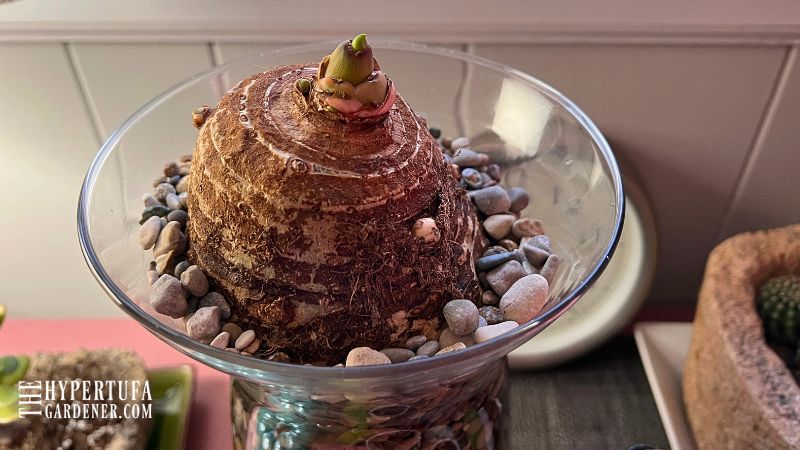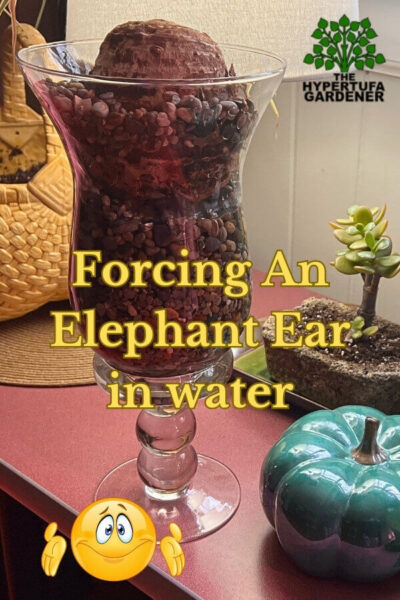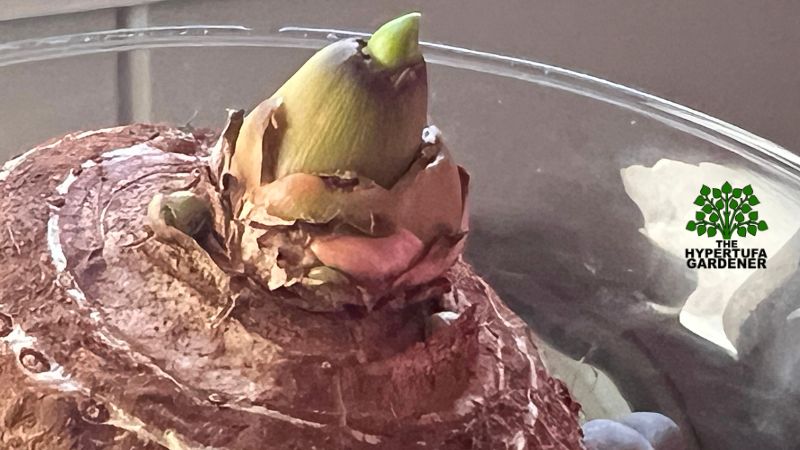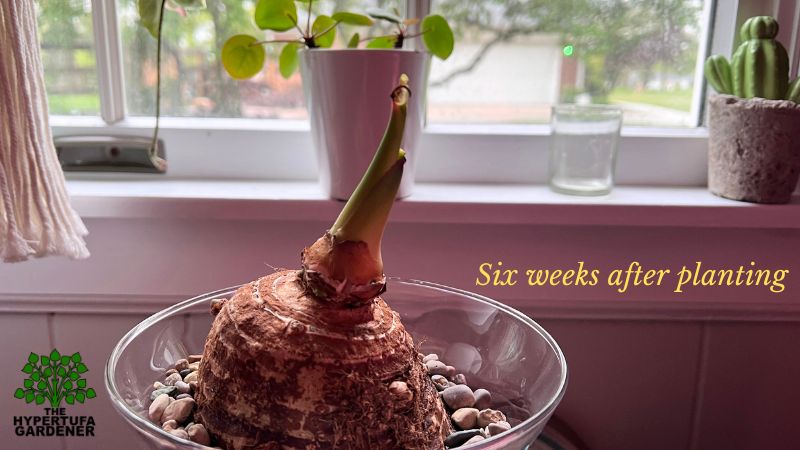Can I Force An Elephant Ear in Water? – I Tried It!
This spring while waiting to garden outside, I decided to try forcing an Elephant Ear in water like one would a Hyacinth or Paperwhites.
Elephant ears are a beautiful choice for indoor and outdoor gardeners due to their large and striking leaves. While I have often grown them in the ground and containers, I wondered if it is possible to force elephant ear corms/bulbs/tubers, whatever! to grow indoors. In water…..hmmm.

So I decided to try it. Spoiler Alert: It was an Epic Fail!
So What Is The Benefit?
Would forcing elephant ears in water offer any benefits? First, it allows me to enjoy the beauty of these plants indoors, earlier even during the colder months. And a head start for spring.
Secondly, it is a great way to see the plant as it grows and check the roots easily, recognizing a problem as soon as it happens.

Also forcing elephant ear in water could simply be a low-maintenance way to grow these plants, making it a great option for those who may not have a large area outdoors.
What You Will Need
Before you start the process of forcing an elephant ear in water, there are a few supplies you will need to gather. These include:
- Elephant ear : Choose a healthy and plump EE, as this will produce the best results.
- Glass vase or jar: Choose a vase or jar that is tall enough to accommodate the growth of the plant, with a not-too-narrow opening to make it easy to remove
- Pebbles or gravel: These will provide support for the Elephant Ear and prevent it from tipping over.
- Water: Make sure the water is clean and free of chlorine, as this can damage the bulb. Catch some rain water.
- Plant food: I think it best to include some water soluble plant food in the water to be sure the plant has extra nutrients.

Here’s What I Did?
Step-by-Step for Forcing an Elephant Ear in Water
Fill the glass vase or jar with pebbles or gravel to about one-third of the way up. This will provide support for the bulb or corm and prevent it from tipping over.
Place the elephant ear on top of the pebbles or gravel, with the pointed end facing upwards. Make sure the bulb is centered in the vase or jar.
Add water to the vase or jar, making sure it covers the base of the corm but does not touch the top. The corm should be in contact with the water, but not submerged.

Place the vase or jar in a bright but cool location, such as a north-facing window. Be cautious of direct sunlight if you are using a clear glass container.
Check the water level regularly and refill as needed to keep the base of the corm in contact with the water.
Within a few weeks, you should start to see growth from the top of the corm. As the leaves emerge, you may need to move the vase or jar to a larger container to accommodate the growth.

Best Laid Plans Go Downhill Slowly
After about six weeks in the water, there were no roots showing at all and the single “sprout” on the top was all the growth I could see.
Some small green nubs appeared lower down on the bulb but never changed size or emerged further.
As the weather warmed up outside in late May, I decided to get it out of the water and just plant it outside in the soil along with the other large Elephant Ear bulb I had.

This second bulb was a larger bulb and I had saved this larger one for planting because I didn’t want to waste the larger one, just in case the water experiment caused the other bulb to rot.
I was surprised to find NO ROOTS at all in the water-grown bulb! No sign of rotting, but no roots either. Perhaps if I waited longer? No, I needed to get these growing outside since it was warm enough.
Check out the Youtube video that I made showing a bit of my process.
I planned for two large planters on each side of the sliding glass doors on the patio. Adding Tradescantia zebrina has always worked for me, so I have been water-rooting some cuttings over the last several weeks.
Those are more than ready to go into the soil with the Elephant Ears. I added some Purple Heart just because I like it.

My Conclusion For Forcing Elephant Ear
It did not work for me after waiting for about five weeks for major growth to occur. I had hoped to have an indoor plant to keep in water. But it failed.
Elephant Ears are so pretty outside and I really like having them. In the future, I will just “force” them early in soil inside the house and set the whole planter itself outside when the weather is right.
Lesson learned.
I will add a photo later on to show you the progress of the Elephant Ear and this Tradescantia. It has always been lovely so I am looking forward to it.
Update: Here’s the Elephant Ear now!




I have been growing Elephant ears in the ground for a few years now, bringing them in for the winter and keeping the bulbs in a cardboard box, as I live in Pa. and our winters tend to get verrry cold. This year I think I put them out too soon, as their leaves are yellowing, and they don’t seem to be growing at all. You mentioned adding iron to the soil?? Could you elaborate on that??
I have used Irontone or Ironite to some plants that show a yellowing of their leaves. It just takes a small bit to treat and helps the plant absorb nutrients in the soil more easily. I will include a link for the one I have, Irontone, and this is an affiliate link ( I must inform you.)
Thanks Kim, but I couldn’t find the link.
Sorry Elly. I checked again and re-added. It appears to me now to be linked. Hopefully that will help you.